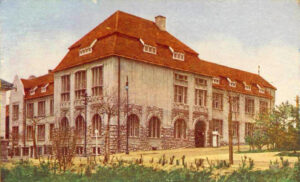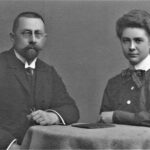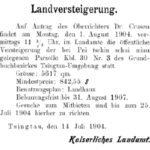Copyright (text and photos) by Wang Dong, Qingdao
In the heart of Qingdao’s historical and protected area, there is a century-old boulevard. During the German lease period, it was named Bismarck-Straße (now Jiangsu Road). As one of the earliest streets in Qingdao, the Jiangsu Road runs from the north to the south through the old city and reaches the Qingdao Bay. The old houses along the street were built more than 100 years ago and have survived to this day. Their long history and often-elegant styles attract many visitors who enjoy their facades and interiors. Among these old buildings, there is one particular century-old house that was built in a rustic style. It is located at the top of the slope on the northern side of the street, at the remarkable six roads intersection (Jiangsu Road, Guanxiang 1st Road, Suzhou Road, Laiwu 1st Road, Fulong Road and Longshan Road). This old building with red tiles and yellow walls has survived throughout the past century, but for a long time, it was not well known.
Over the course of the past century, thanks to the tireless efforts of many researchers, the original owner of this old building was found. Also, his past attempts to introduce German law to Qingdao and integrate it with local customary law slowly came to be known. Many blurred and broken memories of the historical context have gradually become clear.
A German Judge came to the Far East
On September 2, 1902, the royal judge Dr. jur. Georg Crusen succeeded the president of the Imperial Court, Dr. jur. Georg Wilke, and came to Tsingtau to take up his post. In the previous two and a half years, Crusen served as an invited legal advisor to the Ministry of Internal Affairs and Justice of Japan and as a lecturer at the Police and Prison Academy in Tokyo. Georg Diedrich Hermann Crusen was born into a legal family on May 15, 1867 in Meinersen (today: district Gifhorn, Lower Saxony). His father, Hermann Crusen(1835~1907), was a district court judge. Later, in 1877 Georg Crusen entered Hannover’s Rats-Gymnasium (grammar school). From 1886 to 1889, he studied law at the University of Lausanne, Switzerland, and at the universities of Berlin, Leipzig, and Marburg. In 1890, Crusen received his JD from the University of Halle. In 1895, he served as a court jury in Berlin, working for the disciplinary court and the Ministry of Justice for non-judge officers. In 1899, Crusen was appointed a district judge in Frankfurt/Main. In the same year, during the Meiji Restoration in Japan, he was a teacher at the military and internal affairs office. It was an honour for Crusen. The Toyo Island countries were clearly eager to „depart from Asia“ and were thus looking for legal talents like Crusen. Perhaps seeing the sincerity and enthusiasm of the Japanese, Crusen gave up his position as a magistrate and accepted the invitation to go to Tokyo.
-182x300.jpg)
Chinese territory subject to German law
During Crusen’s time at the judicial court in Berlin, the German Navy occupied a bay called Kiautschou (Jiaozhou) in the northern part of China and with the capital named Tsingtau (Qingdao). Between 1897 and 1914, the Germans worked hard to establish and improve the legal order with regards to different factors in Tsingtau. Among the laws enacted and enforced during this period, some were German and some were Chinese. Especially in the field of civil law, German law was applied to litigate between Europeans or between Chinese and Europeans, while disputes between Chinese people were basically settled according to local customary laws. However, by 1912, only 92 non-Chinese violations were recorded in Tsingtau. In addition, in terms of sentencing, the German law was used as moderately as possible. For example, whipping was abolished in Europe in the mid-19th century, and, although it was still used in local customary law, the health of respective prisoners had to be taken into account and evaluated on a case-by-case basis. It happened no more than 25 times. Although there were also cases in which the death penalty was imposed, the execution method was much milder than the torture of the daggers and Lingchi in Chinese customary law.

Along with the establishment of the local and high courts, the German government also stationed the Imperail Judge and the imperial judges who assisted his work in this far-away lease territory. In the summer of 1898, Dr. jur.Paul Gelpcke, the judge of in Hamburg, came to Tsingtau to participate in the establishment of the legal system for the lease of the territory in Kiautschou. He was followed by Crusen’s predecessor, Dr. jur. Georg Wilke, who served from 1900 until 1902. The judges who were assigned to the Imperial Court and the Imperial High Court for 2-4 years had to be familiar with and able to use Chinese customary law. In addition, they were also responsible for applying German law to unfamiliar environments and apply German law to cases involving Chinese parties. According to an imperial decree on October 3, 1910, the Imperial judge directly accepted his position from the German emperor. According to the leasehold of the Kiautschou Bay, the Secretary of State of the Navy assigned all responsibilities.
During his ten years as the Imperial Court of Kiautschou and the Royal High Court, Crusen was committed to bringing German law into Tsingtau and combining it with local customary law. In the „International Criminal Federation Annual Report“, „Colonial Law“ and other magazines, he published the „Modern Thoughts on Chinese Criminal Law in the Kiautschou Lease Territory“ and „The Legal Status of Chinese People in Kiautschou“ in which he elaborated on his views. At the same time, Crusen also strongly endorsed the practice of developing Tsingtau into a German cultural center that would then exert influence on China. In December 1912, he emphasized in his report to the German Colonial Association that the function of the „cultural library“ is one of the most important features of Tsingtau. In the article „Tsingtau as the Cultural Center of Germany“, Crusen also believes that Tsingtau’s model planning can make Chinese administrative officials learn a lot. This view also coincides with Sun Yat-sen (1866~1925) who visited Tsingtau in late September 1912.
“The opera judge“ and the matchmaker Richard Wilhelm
On August 1 st, 1903, less than a year after coming to Tsingtau, due to his outstanding work performance, a decree from Berlin made Crusen a lifelong judge. In the leased territory, this position was only one level lower than the Governor of Kiautschou, who held all military and administrative powers. In addition to his profession as a judge, Crusen was also active in the music scene of Tsingtau. The judge not only participated frequently in opera rehearsals, he also served as a mixed choir conductor and piano accompaniment. The music of Wolfgang Amadeus Mozart (1756~1791), Franz Schubert (1797~1828), Johannes Brahms (1833~1897) and Hugo Wolf (1860 – 1903) – a close friend of him – appeared in his repertoire. Playing music by familiar master composers was probably a relief for the homesick Germans who were living far away from their homeland. Because of his enthusiasm for the music industry, Crusen also had the nickname „Opera Judge“ in Tsingtau.
-194x300.jpg)
Because of their common love for music, Crusen became a frequent visitor of the famous Sinologist Dr. Richard Wilhelm (1873~1930). They often discussed and shared their feelings and experiences of music together. In October 1907, 23-year-old Amalie Davidsen (1884~1973) who was temporarily living at Dr. Wilhelm’s home.
This is how Crusen and Amalie came to know each other. And thanks to the matchmaking efforts of Richard Wilhelm, on May 22, 1909, 41-year-old Crusen and 24-year-old Amalie were married; Wilhelm hosted a church-style wedding at his home. In February 1910, her daughter Helga Crusen (1910~1989) was born; her godmother was Salome Wilhelm (1879~1958). Mrs. Crusen resigned from her work at the Royal Girls School and she stayed at home with her husband. In December 1911, their son Harald Crusen (1911~1996) was also born in Tsingtau.
Garden-Villa built by F. H. Schmidt,Tsingtau
Since coming to Tsingtau in 1902, Crusen had been living on the northwestern corner of the intersection of Hunan Road and Jiangsu Road in a place that had originally been prepared by the Government’s Office in 1901 for his predecessor. This gray brick and black tile house with its sleek brick and wood structure, was located adjacent to Bishop Anze’s Apartment built in 1899. His decision to marry as well as his long-term desire to settle in Tsingtau should have been the main reasons for Crusen’s decision to purchase land and build his own home. According to an announcement published in the „Amtsblatt für das Schutzgebiet Kiautschou“, in January 1910, Crusen invested 2,687.54 Yuan to purchase 3,238 square meters of official land on Bismarck Street for the construction of his own home.
The land purchased by Crusen is located between Bismarck Street, Elizabeth Street (now Qidong Road) and an unnamed road on the east side (now Longshan Road), and to the west separated from the Government’s Hospital, which was built in 1898. Although this land is more than five times larger than the adjacent No. 4 land, it is long and narrow and extremely irregular. The judge selected the area on the north side of the plot overlooking the sea and commissioned F. H. Schmidt, the largest real estate agent inTsingtau, to design and construct his villa. The current information does not mention who the designer of the house was, but the items preserved by the Crusen family have a pencil-painted sketch of the south facade of the house. However, judging from lines and techniques, it is likely that Crusen himself painted it according to his memories after leaving Tsingtau. The rest of the plot was used to create a private garden. This narrow garden decorated with flowers has become a chic streetscape of Jiangsu Road and Longshan Road.
According to a photo album of F. H. Schmidt (Tsingtau), the villa of the judge was built within one year. This two-story villa had a basement; it was facing south, had a clean, well-structured facade, a mansard-style fold-over roof and was located adjacent to quartermaster Villa Solf of Eduard Meyer & Co whose villa was exactly the same. The prominent gables on the south façade emphasize both the central axis and the roof curve. The outer balcony on the second floor adds facade changes and contrasts. The foundation is made of rough granite and stretched to the first floor, and a rough granite-built terrace is added to the south to make the building look solid and stable. The north facade forms a symmetrical three-segment central axis. The gables of the two wings echo the south façade. The main entrance is slightly inwardly retracted. Two consecutive arches are supported by short granite columns. The German historian Christoph Lind (*1964) believes that the facade of the judge’s residence is simple and rigorous, and largely waives the use of the decoration. This less decorative, less splicing and “bringing”, moderate use of balcony or veranda style changes is also a proper reflection of the prevailing trends in German domestic architecture.
War and shelter in Shanghai
After the First World War broke out, Japan and the United Kingdom dispatched their navies to attack Tsingtau. The disparity in military power and isolation marked the end of Germany’s rule in Tsingtau. Crusen first asked his wife and two children to take refuge in Laoshan where they had a cabin.
Crusen himselve took part in the peacetalks of the Chinese and Germans with the Japanese. In these talks his knowledge about the Japanese language was very helpful. When the Japanese were about to occupy the German coalmine in the hinterland of Shandong, they rushed to Shanghai. The 47-year-old Crusen did not participate in the hopeless city defense battle. In November 1914, he came to Shanghai to reunite with his family and was responsible for the work of the Kiautschou Department and the consular jurisdiction at the German Consulate General in Shanghai. Soon after, Tsingtau was completely occupied by Japan, and the vast majority of Germans who had worked with Crusen became Japanese prisoners of war.
In Shanghai, Crusen continued work until the end of World War I. He was repatriated in 1919 due to the coercion of China’s accession to the Allies and the British and French governments. Concerning the Japanese occupation (1914) he took part in the peace-talks. 1915 to 1919 he worked in the German General Counsolate. Back to Germany in 1920, Crusen served in Berlin as a judicial review board member in the Prussian Ministry of Justice and was the department head responsible for the implementation of the peace treaty. At the same time, from 1920 to 1925, he was also the plenipotentiary representative of the Parliament in Prussia. In 1925, Crusen left the government’s judicial system and worked as president in the Supreme Court of the Free City of Danzig (now Gdansk, Poland). He served as the city head judge from February 1, 1925 until September 30, 1932.
After this time he retired, but remained a consultant for International Law to the City of Danzig. After retirement he moved to souther Germany , in the small town of Gerlingen near Stuttgart. After the end of the Second World War, Crusen, who was nearly 80 years old, still served as a judge in the special courts, which were installed by the Americans against crime of soldiers during Word War II, in Ludwigsburg until his death in Gerlingen on November 14, 1949.
The judge’s residence is another stories
After 1914, Crusen’s residence was owned by the Japanese garnison in Qingdao and was inhabited by military and political officials. In December 1922, Qingdao was returned to China. According to an agreement reached between China and Japan, the house became one of the 11 real estates retained by the Japanese government, and was later changed to the official residence of the Consul General of the Japanese Consulate in Qingdao. Between 1923 and 1945, a total of 16 consuls stayed there. Among these Japanese consuls many have a background in legal education.
。-300x235.jpg)
After the Chinese victory in the Anti-Japanese War, the Japanese Consulate General in Qingdao announced the closure. In September 1945, the former Qingdao security team captain Li Xianliang (1904~1993) was appointed as the mayor of Qingdao by the Nanjing National Government and became the new owner of the residence. In July 1948, Li Xianliang, who lived here for less than three years, was removed from the post of Mayor of Qingdao. He transferred the property to Fan Chengchuan (1896~1995), the manager of China Textile Qingdao Branch who moved there in March 1949. According to Yu Yingjie’s article on “The Battle of Fan Chengchuan to Protect Textile Mills on the Eve of Qingdao Liberation”, Fan lived at No. 13 Huashan Road, and was organized by the China Textile Corporation to participate in the anti-Southward movement of the factory. Because of terrorist threats from spy organizations, Huashan Road and another one of his residences on University Road were no longer safe. So Fan took the whole family and moved into No. 27 Jiangsu Road.
After the founding of the People’s Republic of China, No. 27 Jiangsu Road was handed over to the People’s Government for management. In December 1954, the Jiangsu Road Sub-district Office was established here. In November 1958, the street office moved to Qidong Road. This old building was used by the public security organs and was given new functions and uses. In May 2006, No. 27 Jiangsu Road was listed as the second list of outstanding buildings in Qingdao.

.jpg)


-150x150.jpg)
-150x150.png)

